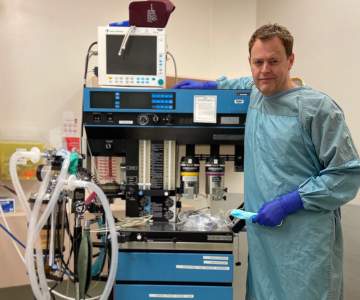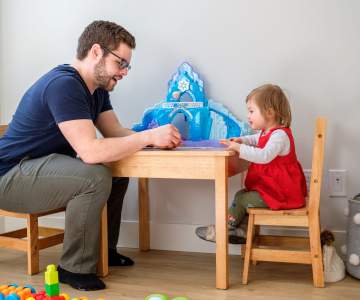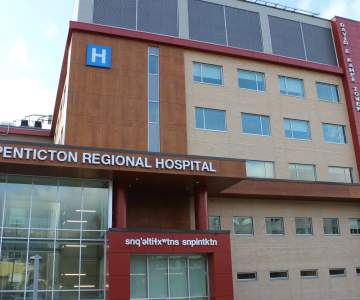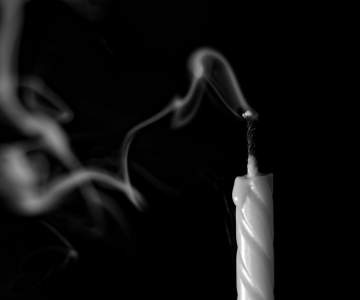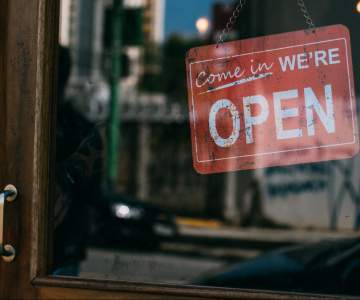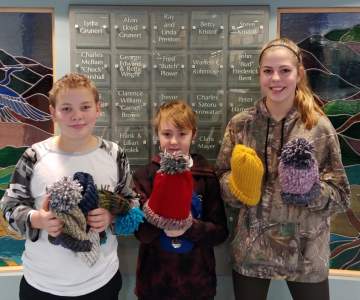Breadcrumb
Explore Stories
Community & Culture
When Williams Lake physician Dr. Ivan Scrooby and infection prevention lead Kelly Dillon were walking through a partially-remediated area of Cariboo Memorial Hospital (CMH) in Williams Lake earlier this year, inspiration struck.
The two were inspecting an area of the hospital that was already under construction and included ambulatory care, part of patient registration and the cardiology department. The area had been damaged by floods in January, the result of a series of burst pipes due to severe cold temperatures, and a negative pressure system was in place to remove construction dust from the area.
Due to the construction, the area was already cordoned off and completely separate from the rest of the hospital; the area was fully enclosed and fans were moving air outside as part of the remediation work.
At that time, the COVID-19 crisis was just beginning and hospitals had been asked to postpone surgeries and prepare for what could be an increase in patients who were ill due to COVID-19. Dr. Scrooby and Kelly immediately saw an opportunity to create a protected patient care area that would help limit the virus from spreading throughout the rest of the hospital.
“We went down together to have a look at the repairs and, when we walked through the space, we realized it had the potential to become a negative pressure space without having to do too much work,” says Dr. Scrooby, who inquired of the contractors if the negative pressure system could remain in place.
Cariboo Memorial Hospital in Williams Lake created a negative pressure area to allow staff to treat patients with COVID-19.
“From there the idea grew and we worked with our team at CMH and the contractor to make a few more improvements so we would be ready for potential COVID-19 patients.”
“Our departments had already been juggled around because of the flood repairs,” says Thalia Vesterback, CMH Director of Clinical Operations. “The silver lining was we had already looked at space utilization and that space that was under construction in our pandemic planning. It was a perfect solution to use the space that was being remediated due to the floods.”
* * *
During a particularly frigid cold snap in January, CMH was hit by a series of burst pipes and the hospital was thrown for a loop with its main, emergency and temporary public entrance all having to close down during the same week.
Temperatures had plunged below minus-30 C. Pipes were failing and water leaked throughout the hospital. The main water system to CMH had to be shut down. A few services became unavailable but, through it all, patient care wasn’t impacted.
“We had five separate pipes burst over a week and it kind of became like Groundhog Day, with staff responding all over again every day, in all of the different units,” says Thalia. “It really did bring everyone in the building together and there was just exceptional teamwork from all of our staff and physicians.”
Once the temperatures rose above normal, it was time for remediation work to begin. A large area was hoarded off as a restoration company worked to repair areas that were damaged. As repairs were nearing completion, hoarding remained up and a negative pressure system was in place to protect staff and patients from any construction dust. It was then that the province was hit with the COVID-19 crisis.
Enter Dr. Scrooby and Kelly Dillon's light-bulb moment. When the contractor returned to CMH to complete the restoration work, a few tweaks were made to the area. Two separate staff entrances were established where physicians and nursing staff could enter and don Personal Protective Equipment (PPE), and then exit when treatment was complete. Patients would also have a separate entrance, maintaining isolation protocols during the COVID-19 crisis.
“We are eternally grateful for all of the team players that made this happen,” says Dr. Scrooby. “It’s very comforting to treat patients that are very sick in the unit because we know we are limiting the exposure risk. With the staff and physicians wearing the proper PPE, we are protected, and so are the staff and the patients that are admitted into the regular hospital. I want to extend my gratitude to everyone for all of their hard work. We are serving a large rural community so it’s a bit challenging at times, but this has gone a long way in helping us if we have an outbreak to deal with.”
“This is just one more example of how amazing our health-care team is at Cariboo Memorial,” adds Kelly. “We work hard every day and it shows.”
Thalia echoed both of those comments, heartened by the way everyone pulled together, not only at the start of the COVID-19 response, but to the flooding earlier in the year as well.
“I think everybody has been fabulous, they have been amazing,” she says. “Everyone just pulled together. It started with the flooding and people chipping in and asking ‘how do we do this?’ Everyone was willing to come together and discuss solutions to the problem. It was a lot of effort from so many people and it really ended up being a great thing.”
Community & Culture
Medical students based at the UBC Okanagan campus in Kelowna are helping front-line physicians in the battle against COVID-19 in the B.C. Interior.
With the temporary suspension of clinical training in hospitals and clinics across the province, many medical students began looking for other ways to support physicians and patients during the pandemic.
Over 80 students joined the B.C. COVID-19 medical student response team, a UBC student-led initiative supporting physicians and volunteer projects in all regions of the province.
“Volunteering is a tangible and effective way to make a difference,” says Alex Monaghan, medical student and volunteer organizer. “We wanted to get involved out of appreciation and gratitude for those working to keep us protected and safe.”
From providing childcare and personal assistance to physicians, to supporting patients remotely, students have rallied together to offer their support across the Interior Health region.
Students have helped configure tablets with video messaging applications to help patients at Kelowna General Hospital (KGH) stay connected with their families. They also recently launched a meal preparation and delivery service to support physicians and their families.
“As we adjust, both personally and professionally to the new realities of life with COVID-19, I’m deeply encouraged by the generosity and solidarity of this newest generation of future physicians,” says Dr. Sarah Brears, Interim Regional Associate Dean for the Southern Medical Program and family physician. “The extra support they’re offering to the community is helping many physicians stay focused on their work and their patients.”
Medical student Brian Hayes is one of the volunteers helping out by entertaining the busy 18-month old of a local physician working at KGH.
For Hayes, volunteering is a small way to give back during an unprecedented time.
"As individuals committed to providing care to the public, we have a strong desire to assist those on the front lines,” says Hayes. “Volunteering our time to support physicians with an inflated workload or help with projects such as contact tracing allows us to be engaged in the COVID-19 response."
As the COVID-19 pandemic continues to evolve, students remain committed to volunteering with projects that can support physicians, patients, and the health-care system as a whole.
“We chose medicine because we have a deeply ingrained desire to make a difference in the lives of those around us,” says Monaghan. “Those values don’t disappear just because there’s a pause in our clinical training. We’re here to help in whatever form that takes.”
Reprinted with permission from The University of British Columbia, Okanagan Campus
Community & Culture
One year ago on April 29, Maureen Thomson was sitting at a desk inside the new David E. Kampe Tower at Penticton Regional Hospital (PRH), looking over a set of computer screens, each one flashing patient names and locations.
At the time, Maureen was the health services director and responsible for moving some 65 patients from their hospital rooms to new single-patient accommodations inside the David E. Kampe Tower. The tower, a six-storey addition to PRH that also included a parkade, was ready to open its doors to the public.
Construction had begun in 2016, while planning had taken place for many years prior. It was the culmination of a four-month period known as 'operational commissioning', the period after construction completed and Interior Health had moved in equipment, trained staff, and ultimately moved patients from the older building into the new tower. Years of hard work were coming together in one emotional day.
One year later
Fast forward a year.
The new building is all that was expected, and maybe more. Since the earliest days of planning, it was felt the state-of-the-art tower could change the way health care was delivered at PRH, impacting patients not only in Penticton but right across the region.
According to Carl Meadows, a senior leader in acute and community care in the South Okanagan, it has done just that. “The tower has had a huge impact on patient care for residents of the South Okanagan and Similkameen. There is so much more space right from the main entrance to the clinics and into the single-patient rooms. We are thrilled to have this building as a jewel of health care. It really allows our staff and physicians to thrive and provide exemplary care for patients. It’s a great healing environment for patients, something David Kampe himself was extremely proud of.”
In fact, Mr. Kampe, the philanthropist who donated millions of dollars towards the tower which bears his name, often told Carl that he wanted the hospital to be like a five-star hotel.
The opening ceremony of the new tower included David Kampe and other key members of the PRH project including Dr. Brad Raison, Maureen Thompson and Carl Meadows
When he passed away shortly after the tower opened, the hospital received his Order of B.C. which honoured Mr. Kampe for a lifetime of charitable work. The Order now hangs in the hospital, alongside a stunning array of artwork and sculptures.
And it’s not only the art that adorns seemingly every hallway that makes it unique: Aboriginal signage outside the hospital's main entrance, at patient registration, and elsewhere, welcomes visitors and patients in the traditional Syilx language of the Penticton Indian Band, honouring the knowledge keepers of the land.
“We are just so proud of this facility,” says Carl. “So many people played a key role. It was an immense amount of work and a credit to our staff and physicians that we kept PRH operating the whole time and kept putting patient care first. This is a building that matches the skill and compassion of our staff and physicians.”
Dr. Brad Raison was the Chief of Staff at PRH during the planning, construction and opening of the David E. Kampe Tower. He says the tower has brought positive change but stressed there is more work to be done. “We have seen many positive changes at PRH such as nuclear medicine, a permanent MRI, and single patient rooms," says Brad. "This is merely the beginning. Medicine is constantly changing and with it the need for more and new tools to support these changes. We must continue to build on what we have started. Today’s dreams can be tomorrow’s reality.”
Through the eyes of a patient
When Graham Tungate entered the doors of the David E. Kampe Tower earlier this year to prepare for surgery, the 77-years-young Penticton native was feeling some of the anxiety that goes with any impending procedure. However, the atmosphere in the Kampe Tower put him at ease. “In spite of the continual activity, what is noticeable is the quiet,” says Graham. “The design has allowed an ambiance of peace, quiet and comfort to develop.”
The new coffee shop and the heritage photographs on display also helped to take his mind of the impending procedure.
Beyond the calm and welcoming atmosphere, something else stood out for Graham. “I have to mention something very important that directly affected me as a patient: The culture of the medical staff. It is a team culture and like all good, successful teams, it generates its own energy, which is greater than the sum total of the parts,” says Graham. “The medical staff have high standards, they have pride in their work, but more important than that, they care. They have kindness and compassion. Each time that I leave the tower I feel proud that, as Canadians, in our quiet, modest way, we got it right.”
In the end
The opening of the David E. Kampe Tower marked a new beginning for Penticton Regional Hospital. The discussion began long ago among local decision makers to push for a new hospital in Penticton. Years of planning, detailed design work and collaboration occurred between PRH staff and physicians; Interior Health Capital Planning; the Ministry of Health; funding partners like the SOS Medical Foundation and the Okanagan Similkameen Regional Hospital District; stakeholders including the Penticton Indian Band; and contractor EllisDon Infrastructure.
Construction work is expected to conclude in 2022 with a modernized and much larger Emergency Department among the changes.
For Maureen Thomson, who has since retired, it was all about the team. She says everyone involved deserves part of the credit. “This was one of the most remarkable team-based initiatives that you could possibly have,” she says. “Our staff and physicians put their heart and souls into the work and it’s completely evident in the results of the tower.”
On opening day, April 29, 2019, as patients were expertly relocated and an army of volunteers moved hospital beds, cleaned equipment and helped patients, Maureen sat back in awe of what had been achieved. “You don’t get many times in your career that you have the joy of being associated with such a remarkable process,” she says.
Community & Culture
Dealing with a severe speech disorder and transitioning from hospital to home was more than enough for the Freeborn family to cope with. Adding COVID-19 to the mix and hospital visitor restrictions, and problems could have easily gone from bad to worse.
Despite those challenges, this family was able to find a way around those obstacles, with the help of Kelly Talbott, a speech language pathologist at Kelowna General Hospital (KGH).
Larry Freeborn was in hospital dealing with Wernicke’s aphasia, a disorder which makes it difficult for him to understand the meaning of spoken words and sentences. This condition also makes it a struggle for him to use words to express himself in a meaningful way.
Earlier this month, Larry was finally well enough to go home. Prior to leaving KGH, Larry and his family needed help figuring out how to communicate with each other. But with physical distancing regulations at the hospital, the ideal process of face-to-face education in the same room was not an option.
So Kelly devised a work-around to help this family get the support they needed at a critical time in their lives. In the days leading up to Larry’s transition home, Kelly joined his family from a safe distance on their daily visits with Larry though a hospital window.
Through the window, she demonstrated the techniques this family would need to be successful communicating with each other.
Although life inside and outside the hospital is not what it used to be, creativity and a people-focused approach made a big impact in the lives of this family.
Health & Wellness
Is there an older adult in your life? Staying connected despite social distancing can be a real challenge.
Health & Wellness
More than four years ago B.C. declared a public health emergency in the face of unprecedented overdose deaths.
Since that time, more than 789 lives have been lost within the Interior Health community.
Important progress has been made and the evidence is promising. Research from the BC Centre for Disease Control shows that harm reduction efforts are saving lives.
"While the number of overdose deaths declined from 2018 to 2019, there are still countless families reeling from the unfathomable grief of losing a loved one. Now, we are facing a global pandemic on top of a fentanyl-poisoning crisis." -- Judy Darcy, Minister of Mental Health and Addictions
Some of the ways we've been working to reduce overdose deaths in our communities are:
Introducing overdose prevention services and mobile supervised consumption servicesImproving our ability to track overdosesParticipating in the B.C. Take Home Naloxone programEnhancing access to opioid agonist treatmentsExpanding mental health and substance use services, such as increased outreach and follow-up efforts Last year the Burning Bright candle display commemorated the anniversary of the overdose crisis and marked the number of lives lost to overdose.
“In this unprecedented time of two public health emergencies, we must work together to both flatten the curve and stop overdose deaths. We cannot afford to stop caring about one health-care crisis as we stare down another. -- Judy Darcy, Minister of Mental Health and Addictions
Interested in learning more? Read the Minister’s statement about the ongoing overdose crisis and the challenges of having two health emergencies.
Health & Wellness
Penticton resident George Garland has a deep and personal connection to health care in the South Okanagan. His beloved wife Marie spent quite a bit of time at Penticton Regional Hospital while receiving care for Parkinson’s disease and her other health issues.
In memory of Marie, George has donated $100,000 for medical equipment at Penticton Regional Hospital.
George says he was smitten with his future wife Marie almost from the moment he met her at an Edmonton diner more than 66 years ago. In the early 1950s he was working as a heavy equipment operator in Edmonton and often had dinner at the same café where Marie worked as a waitress.
”I used to eat there nearly every night,” George says. “Our first date went well and we hit it off.”
The couple moved to Penticton in 1991.
Several years later, Marie’s health started to decline. “She spent quite a bit of time in the hospital. At one point the doctor took me to the chapel and said he didn’t think she would make it, but she pulled through,” says George.
In her later years, Marie also suffered from Alzheimer’s. She passed away at a care centre in Summerland in September 2018.
George’s donation to the South Okanagan Similkameen Medical Foundation will go a long way towards helping patients at Penticton Regional Hospital. Construction is already well underway on the second phase of the hospital expansion, including a major upgrade to the Emergency Department scheduled for completion by the fall of 2021.
Marie and George
Community & Culture
A cove is considered a safe harbour in a storm.
“Bro’s Cove” in Cranbrook is no different.
The men’s consignment store opened in September 2018 and is run by the Kootenay Initiative Program (KIP), one of Interior Health’s Community Mental Health Programs. It offers support and training for men with mental illness.
“It isn’t just a job for me. It’s a safe environment, where I feel better,” says Brandon. “It gives me a sense of accomplishment that everyone needs. I feel like this is a really good place. All the help they give me – it’s a God send.”
Brandon is one of eight staff members who work in the store. Many of them were part of the initial planning and have been involved in developing the store from the ground up, taking business courses and building a business plan, marketing, gathering donations and designing the store, right down to picking the name and the surfside décor theme. In planning for the store, the green aspect of recycling clothing was appealing to the group. And as an added bonus – there are great deals to be had.
“These fellows all have a chronic and persistent mental illness like schizophrenia or bipolar disorder. Many have struggled to be accepted their whole life, and here they can be exactly who they are. We will work with them to help them become the best they can be by becoming involved in a work program. It is our hope that the clients move toward a future that feels hopeful, promising and meaningful,” says Program Coordinator Donalee Duncan.
“The store also provides a connection to the larger community. We know that work is essential to recovery and growth. Work enhances self-esteem, social belonging and independence.”
The program is based on the principles of psychosocial rehabilitation and recovery. That’s the medical term for a program that promotes personal recovery, community integration, and satisfactory quality of life for persons who have a mental illness.
Bro's Cove is open from 10 a.m. – 4 p.m. Monday, Wednesday and Friday and employs eight people.
“We are the only men’s consignment store in town. We offer a great price and it’s a great place to work,” says Brandon.
Brandon works at the store every Friday. He keeps busy taking in consignments from customers and getting the clothes onto the floor. He runs the till most days, and enjoys his interactions with coworkers and the public – an important part of healing and wellness.
Ryan, a fellow staff member at the store, agrees. The experience has helped him not only boost his confidence but, the experience of helping to develop the business case allowed him to use his business background (he co-founded a roofing company in the past).
“I did a lot of the development with the business group (Business Initiative Program). I learned a lot. I have a lot of prior business experience, and took a lot of business courses. I got to utilize a lot of what I learned.”
“I get a good feeling from using what I learned. I like working with people, and the customers that come in really like it. It’s a good service to the community too. We have a lot of regular customers who come in. They have lots of positive comments about the store.”
“It makes me feel successful.”
Photo credit: Fiona Davidson
Health & Wellness
As a Grade 5 student at North Shuswap Elementary School in Celista, B.C., Liam Smith was known for his confident, caring and courageous personality.
The affable youngster made a big mark on his community in only a short time. After a tragic accident claimed Liam’s life, his classmates struggled to process the loss of their friend. As part of their healing process, the students wanted to honour Liam with a special project.
In finding a way to remember their friend, they discovered a love for knitting, and a way to give back to the community with the birth of Lids from Liam.
“It was a way for the students to relax and to focus their feelings,” says Brad Schmidt, a teacher at the school. “Stitch by stitch, the students learned to pour their grief into a project and create something.”
Lids from Liam saw the students knitting toques for patients at Royal Inland Hospital (RIH) in Kamloops.
Liam and his family have a strong connection to RIH. He was born at the hospital in 2006. After he was seriously hurt in an ATV accident, Liam was rushed to RIH. Sadly, he succumbed to his injuries while under the care of physicians and staff. His legacy of caring lives on as his family donated his organs and saved the lives of four children in B.C.
Today almost 2,000 toques have been donated to RIH. Most of the toques have gone to pediatric patients, although in recent years the RIH Auxiliary has been selling toques at their gift shop and downtown store, with the funds going right back to the health and comfort of patients and staff at the hospital.
In life, Liam Smith had a zest for life and courage beyond his years. Lids from Liam is a fitting tribute to a caring member of the Thompson region.
Little Kylee was born at RIH and snuggles with her dad
while wearing a Lids from Liam toque
-
Load More
Showing 765 of 789
Sign up for email updates
Receive news, alerts, public service announcements and articles right to your inbox.


